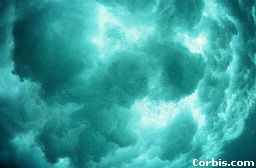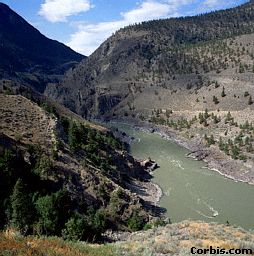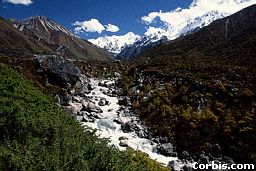

 In the past, scientists have observed boils at the surfaces of rivers, but
did not know their origin. To find their cause and where they originate, some scientists
have studied turbulence in rivers. Bennet and Best (1993) studied turbulence over dunes,
using laser Doppler anemometry to measure the horizontal and vertical components of the
turbulence. They found that the horizontal component of velocity was highly turbulent in
the zone of flow separation, and downstream of reattachment. They also found that the
vertical component of velocity was highly turbulent above and immediately downstream of
the separation zone, and it was also highly turbulent along the free-shear layer. This
turbulence along the free-shear layer caused ejections. Ejections are frequent, energetic
movements of fluid vertically, and are sometimes called quadrant II events. These
ejections are important for the suspension of sediment, and also explain the presence of
stresses. The turbulence is also important for dune stability. These ejections from the
free-shear layer, not turbulence generated within the separation zone, may be responsible
for the surface boils.
In the past, scientists have observed boils at the surfaces of rivers, but
did not know their origin. To find their cause and where they originate, some scientists
have studied turbulence in rivers. Bennet and Best (1993) studied turbulence over dunes,
using laser Doppler anemometry to measure the horizontal and vertical components of the
turbulence. They found that the horizontal component of velocity was highly turbulent in
the zone of flow separation, and downstream of reattachment. They also found that the
vertical component of velocity was highly turbulent above and immediately downstream of
the separation zone, and it was also highly turbulent along the free-shear layer. This
turbulence along the free-shear layer caused ejections. Ejections are frequent, energetic
movements of fluid vertically, and are sometimes called quadrant II events. These
ejections are important for the suspension of sediment, and also explain the presence of
stresses. The turbulence is also important for dune stability. These ejections from the
free-shear layer, not turbulence generated within the separation zone, may be responsible
for the surface boils.
Drake et al. (1988) also studied turbulence, using motion pictures to view bedload particle motion. They found that sweeps, which are high velocity parcels of water moving downward, cause sweep-transport events. The sweeps entrain particles from the bed at a high rate and carry them downstream at a high velocity, eventually dissipating. The sweeps move over the surface in waves. The sweep-transport events were random in time and space, but were strongly influenced by the presence of advancing slipfaces. They also found that displacement distances of bedload particles were about fifteen times the particle diameter, but particles of different sizes usually travelled at similar speeds. Also, the average rate of entrainment of smaller particles was greater in regions of finer sediments, and this could be because when larger particles are present, they protect the smaller particles from being entrained. In addition, the entrainment rates seem to control the transport and distrainment rates of the particles. Bedload transport is controlled by the velocity field of the water, and thus by the mean shear stress and the sizes and arrangement of the particles on the bed.
 Kostaschuk and Church (1993) also investigated turbulence. They used an
acoustic profiler and an electromagnetic current meter to study large turbulence
structures in the Fraser River. Boils on the surface of rivers are formed by kolks, which
are slowly rotating, upward-tilting vortices. Kostaschuk and Church found disturbances
above the dunes through acoustic profiles. The disturbances, believed to be kolk-forming
events, formed on the lower stoss sides of dunes, and appeared at the surface of the water
as boils, tens of meters downstream. The researchers grouped the disturbances into two
subpopulations by their frequency. The lower subpopulation is associated with continual
wave instability on the lee side of dunes. The higher subpopulation is associated with
intermittent ejections from the dune field internal boundary layer. It appears that kolks,
and thus boils, are not formed from microturbulence.
Kostaschuk and Church (1993) also investigated turbulence. They used an
acoustic profiler and an electromagnetic current meter to study large turbulence
structures in the Fraser River. Boils on the surface of rivers are formed by kolks, which
are slowly rotating, upward-tilting vortices. Kostaschuk and Church found disturbances
above the dunes through acoustic profiles. The disturbances, believed to be kolk-forming
events, formed on the lower stoss sides of dunes, and appeared at the surface of the water
as boils, tens of meters downstream. The researchers grouped the disturbances into two
subpopulations by their frequency. The lower subpopulation is associated with continual
wave instability on the lee side of dunes. The higher subpopulation is associated with
intermittent ejections from the dune field internal boundary layer. It appears that kolks,
and thus boils, are not formed from microturbulence.
Lapointe studied burst-like turbulence in a sandy channel. These ejection and inrush events were short and intense. They caused Reynolds shear stress through intermittent momentum exchange. The ejection and inrush events vertically mixed the suspended sediment, and maintained sediment transport. Although they are associated with sudden increases in suspended sediment, the association is complex, so that some strong upwellings will not lift much sediment. Eddies with a sudden upward flow and then flow deceleration transported the highest concentrations of suspended sediment. Lapointe also found that the ejection and inrush events were not predictable in time. He concluded that although some believe that surface boils are caused by eddy shedding from the lee side of dunes, and not by bursting motions, this required more research.
 Robert et al (1996) also studied turbulence, using electromagnetic
current meters to measure velocity longitudinally and at various heights above the bed.
They found that the flow structure seems to be dominated by vortices shed from the lee
side of obstacles. Protuberant clasts, large particles protruding from the bed, modified
the turbulence structure, increased the turbulence intensity and dominated turbulence
generation. They caused flow separation at the base of velocity profiles and increased the
local boundary shear stress. There was a layer of flow from the top of the protuberant
clasts to the bed, in which the flow was generally towards the bed, and with intense
eddies. The layer immediately above the protuberant clasts had flow generally upward. This
was probably from the flow being forced around the protuberant clasts and then upward.
Sweep-like and ejection-like events near the bed caused higher turbulence intensity and
higher mean Reynolds shear stress. The authors also found higher turbulence intensity in a
rougher section in the channel than in a smoother section.
Robert et al (1996) also studied turbulence, using electromagnetic
current meters to measure velocity longitudinally and at various heights above the bed.
They found that the flow structure seems to be dominated by vortices shed from the lee
side of obstacles. Protuberant clasts, large particles protruding from the bed, modified
the turbulence structure, increased the turbulence intensity and dominated turbulence
generation. They caused flow separation at the base of velocity profiles and increased the
local boundary shear stress. There was a layer of flow from the top of the protuberant
clasts to the bed, in which the flow was generally towards the bed, and with intense
eddies. The layer immediately above the protuberant clasts had flow generally upward. This
was probably from the flow being forced around the protuberant clasts and then upward.
Sweep-like and ejection-like events near the bed caused higher turbulence intensity and
higher mean Reynolds shear stress. The authors also found higher turbulence intensity in a
rougher section in the channel than in a smoother section.
There are different types of turbulence events. Although in the past researchers thought that boils were formed from microturbulent bursting, it now seems that they are formed from ejections on the lower stoss sides of dunes. They appear to originate in the free-shear layer, not in the zone of separation. It appears that more research is needed.
References
Bennett, Sean J. and James L. Best. 1993. Structure of Turbulence Over Two-Dimensional Dunes. In Sediment Transport Mechanisms in Coastal Environments and Rivers, Belorgey, M., R. D. Rajaona and J. F. A. Sleath, editors. 3-13.
Drake, Thomas G., Ronald L. Shreve, William E. Dietrich, Peter J. Whiting, and Luna B. Leopold. 1988. Bedload transport of fine gravel observed by motion-picture photography. Journal of Fluid Mechanics, 192:193-217.
Kostaschuk, R. A. and M. A. Church. 1993. Macroturbulence generated by dunes: Fraser River, Canada. Sedimentary Geology, 85:25-37.
Lapointe, Michel. 1992. Burst-like sediment suspension events in a sand bed river. Earth Surface Processes and Landforms, 17:1-18.
Robert, Andre, Andre G. Roy and Bernard De Serres. 1996. Turbulence at a roughness transition in a depth limited flow over a gravel bed. Geomorphology, 16:175-187.
Spring 1999
| Home | Chemistry | Physics | Astronomy | Biology | Ecology |
| Geography | Medicine | Mathematics | Technology |
| Issues | Scientists | General | Reference |
![]()
Last Updated Monday, August 27, 2007 00:54 -0400
� Suzanne P. Currie 1999 [email protected]